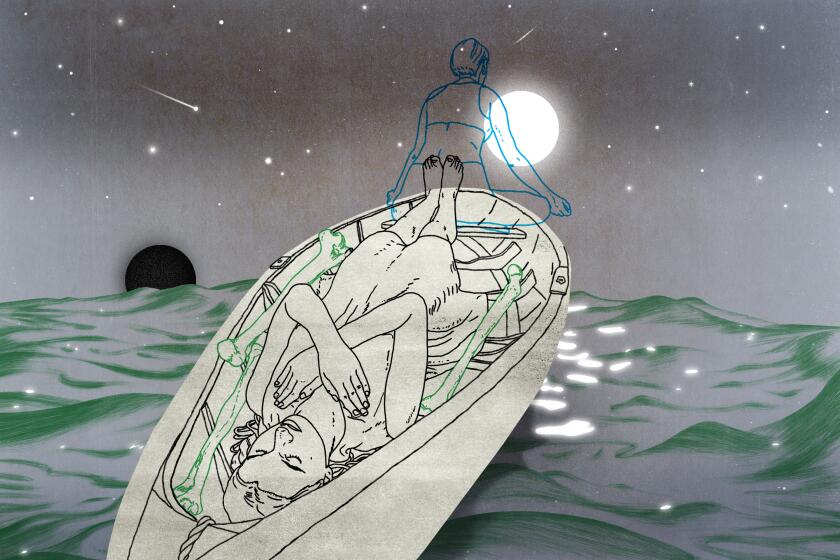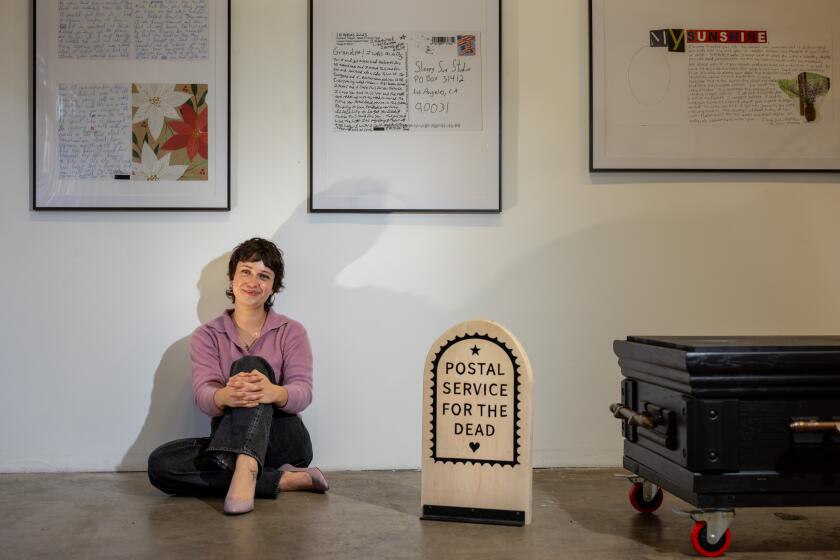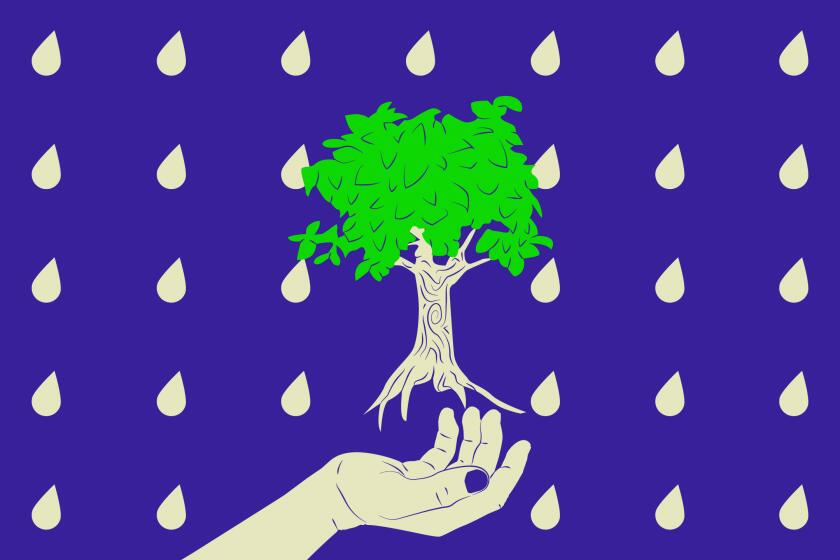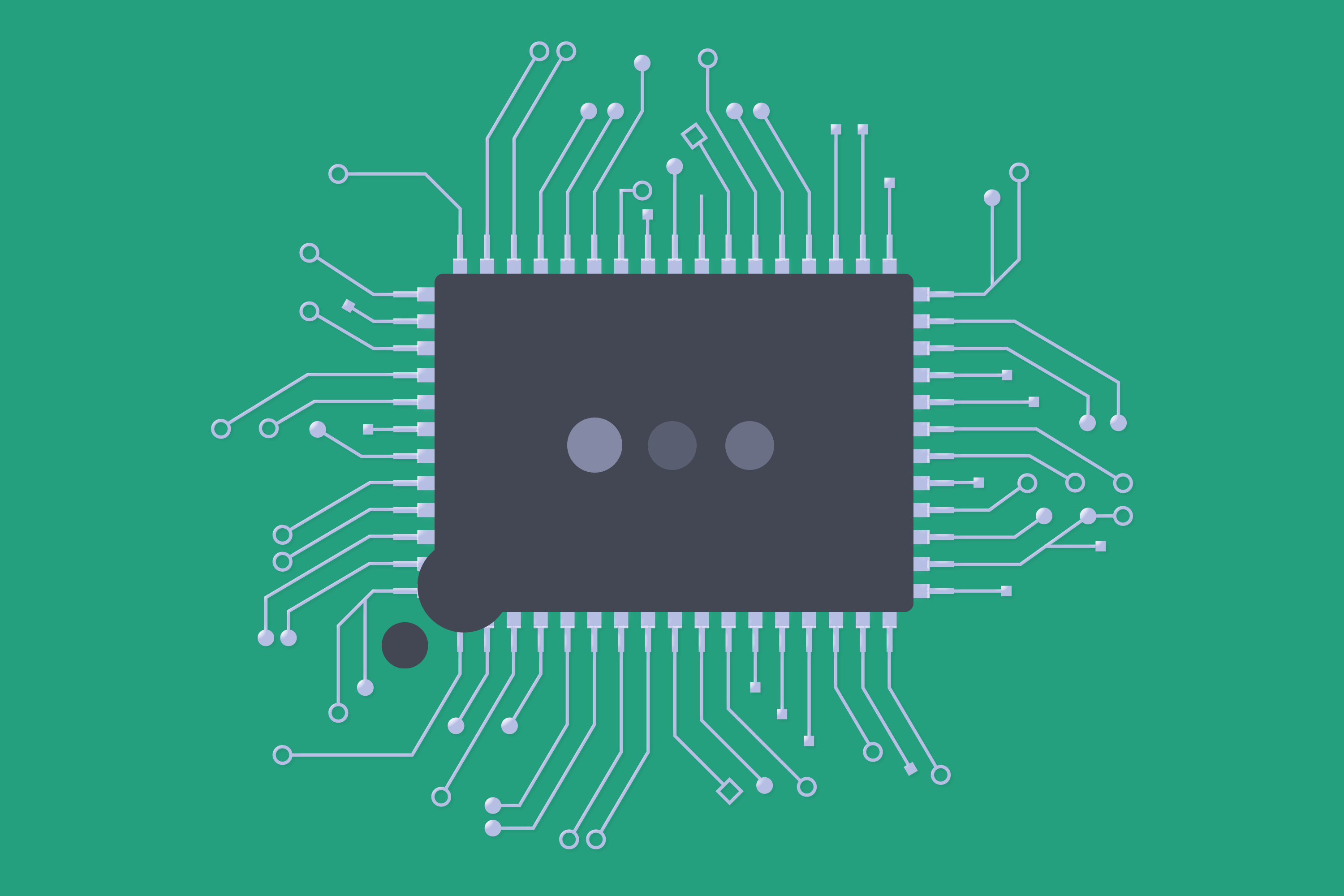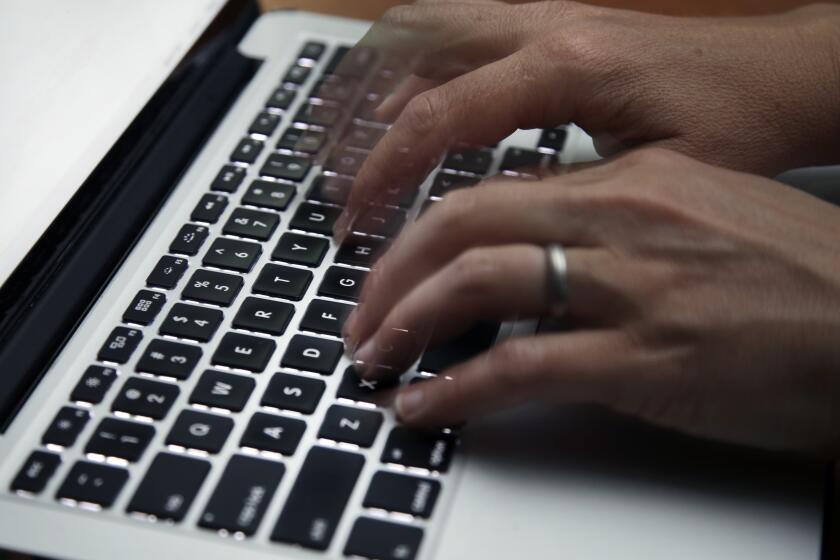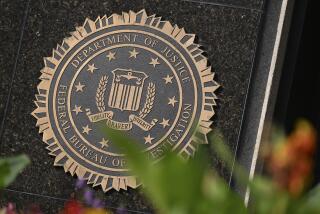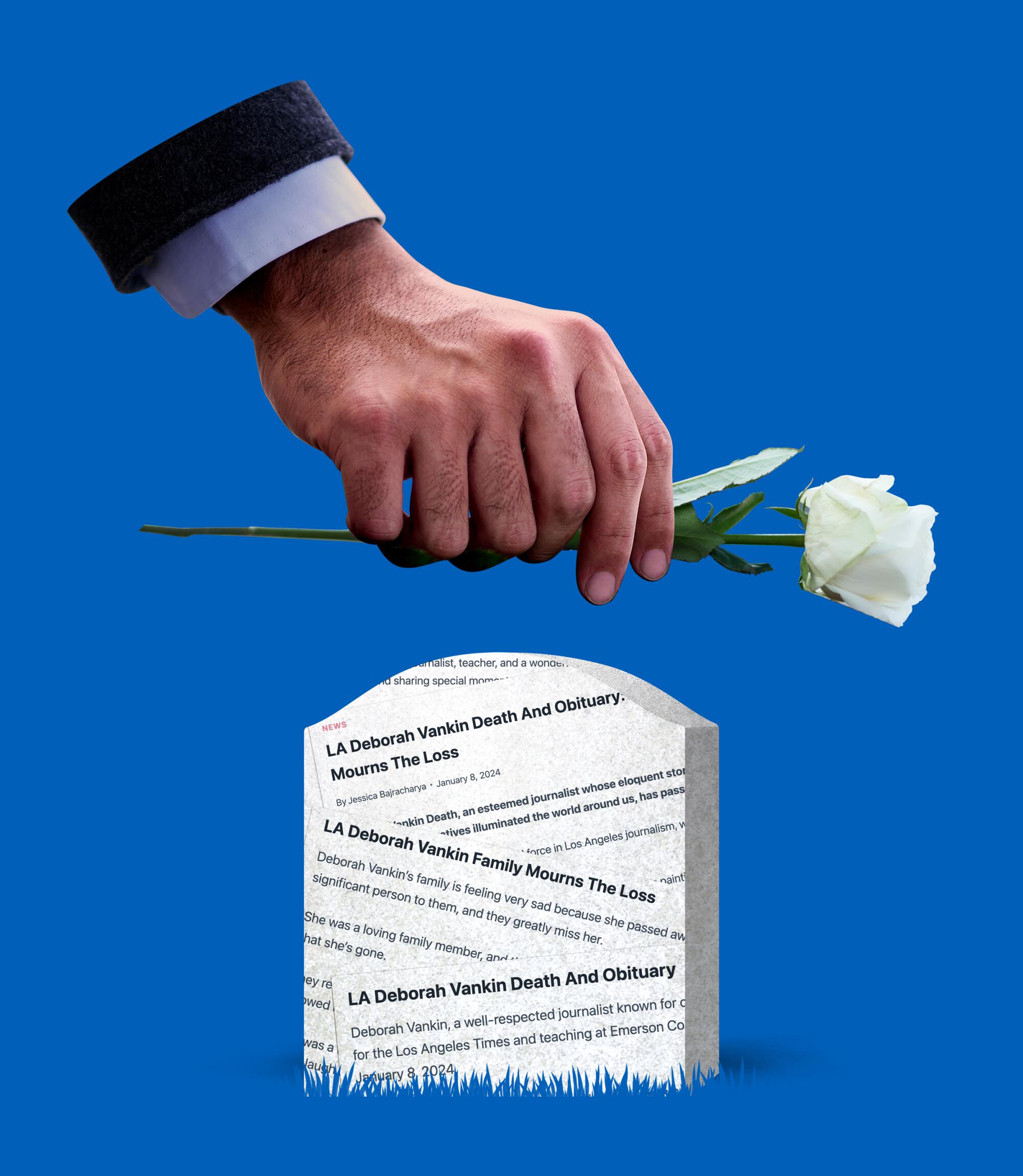
When I died the other day, no one really noticed. That is, aside from a few alarmed members of my family.
“The event,” as I now call it, unfolded one morning last month as I was racing out the door to a meeting. My phone rang.
“De-De-Debbie, hi,” my dad said, nearly out of breath. “Listen: please DO NOT BE ALARMED by what I am about to send you!”
That got my attention.
“It’s an” — he paused for dramatic effect — “an obituary.”
“Oh, my God, for who?” I said, putting down my purse.
“You.”
“What?”
“There’s a rumor going around the World Wide Web,” he said, as if it were 1997, “that you died. Your obituary — it’s going viral internationally!”
He’d heard about it from my aunt, who gets updates from Google whenever my name appears online. I immediately called her.
A death meditation may sound morbid, but often it’s a celebration of life. At a Pasadena shop, you can experience a moving death meditation for yourself.
“I got an alert. It linked to your obit,” she said. Then: “They said some really nice things about you.”
It turns out there were several reports of my death circulating online. And in the words of Mark Twain, they were “greatly exaggerated.”
The lengthy obituaries detailed my career accomplishments and deep ties to family and friends with the uncanny discordance of an AI bot. “Deborah Vankin Obituary, Arts And Culture Writer At Los Angeles Times Sadly Passed Away,” the first headline read. “... Family Mourns The Loss,” read another. “Deborah Vankin, an esteemed journalist whose eloquent storytelling and insightful narratives illuminated the world around us, has passed away.” They cited no cause of death.
The obits, authored by fictional journalists, were part of an elaborate death hoax created by anonymous scammers using my name as clickbait. (I’m not linking to them in this story, so as not to further play into their scheme.)
It was a multimedia operation, I learned from my brother, who’d seen an obit on YouTube. At least four different reports of my death came in the form of videos. One depicted a car crash in the thumbnail, another a coffin exiting a funeral home, another my portrait beside the bright flame of a memorial candle.
“Oh, which picture did they use? Did my hair look OK?” I asked my brother on the phone. He didn’t see the humor.
Postal Service for the Dead, started by artist Janelle Ketcher, provides the living with a way to physically write and send letters to those who have died.
The videos, I soon learned, had real humans in them: an “anchor” at a news desk or a “correspondent” in the field. Each announced my death or — in an amusing scammer counternarrative — relayed that I was, in fact, “alive and thriving” despite “unfounded [reports] circulating on social media.”
In one video, a man in a powder blue blazer rattles off this news, switching between Hindi and English. He’s stiff and awkward, his voice flat as he seems to read off a teleprompter. “Deborah Vankin is one of the most popular arts and culture writers for the Los Angeles Times in America,” he says. (Wildly overblown, but I’ll take it.) At the end he leans in and flips an off switch and the frame goes dark.
It got one view. Sigh.
I don’t often think about death. Oddly, I’ve never been afraid of it. One college summer in Belgium, I chased down a slow-moving train and leaped on because my roommate — and passport — were still on it. I’ve gone hot air ballooning in Arizona, solo hitchhiking in Greece. I parachuted out of an airplane to celebrate a milestone birthday many years ago. I always figured death would come one day, and I was OK with that.
Subscribers get early access to this story
We’re offering L.A. Times subscribers first access to our best journalism. Thank you for your support.
But when the internet reported that I’d died, everything changed. At first, I avoided my obits with the excuse that they were not safe to click. I’d had enough mandatory internet security training to know better than that. When friends sent PDFs and screenshots, I still couldn’t bring myself to read them.
A day turned to two and then several. It wasn’t that I was purposefully avoiding the task. It’s just — well, I was busy. There were work deadlines. Social commitments. The kitty litter needed cleaning — again. Who had time, on top of everything, to deal with their own demise?
Then, about a week later, I drove a friend to an early-morning surgery. It was 5:45 a.m. in the florescent-lit waiting room of a Santa Monica medical facility, eerily quiet but for the scribble of a patient’s pen on intake papers and the shuffling of feet. A home renovation show played silently on the overhead TV screen — they were adding more garage storage.
Perhaps it was predawn languor in that sterile room, or my proximity to so many reminders about the fragility of life. Maybe I was bored.
But that’s when I opened my phone and read the obit.
It set off a domino effect of visceral reactions. My chest constricted and my heart raced.
A wave of profound sadness followed — the type that heaps over you after learning a loved one has died.
Then, a tinge of foolishness. I knew all of this was a hoax, so why the real grief? How stupid! But this prism of all too human reactions was just that — human. I was living and breathing and very much alive. A kind of calm settled in.
I knew all of this was a hoax, so why the real grief? How stupid! But this prism of all too human reactions was just that — human.
I never would have thought of it this way, but death doula Marifel Catalig characterized my reaction as an out-of-body experience. “You were confronted with the reality of your own death and what happens when you get that news,” she said. “That can be profound, a true calling to wake you up to all the things you want to get out of your life when you have the opportunity.”
Over the next week, a relentless cable news-like chyron of must-dos and questions scrolled in my mind: Send out that book proposal. … Get back to Iceland to see the northern lights ... Cremation or burial? I was experiencing a near-death moment, stretched out over days in bits and pieces.
I also had a slew of questions about the hoax itself, so involved it was frightening. To make sense of the scam, I spoke to internet security experts, an AI misinformation analyst, Google and YouTube representatives, professors, even the FBI. No one could say, exactly, who was behind the death hoax, but most everyone agreed it was clickbait.
“It’s a phishing scheme, an attempt to get clicks or viewers,” said Elijah Dittersdorf, owner of the L.A.-based Mom’s Computer, a business that works with seniors on scam prevention and damage control. Dittersdorf said he started seeing this particular death hoax around 2021 targeting “people with a name, but not necessarily the Kardashians.”
People are choosing eco-friendly and creative options for their final resting places, including the bottom of the ocean and miles and miles into outer space.
“It’s happened to a small number of our clients — one was a popular ’70s and ’80s actress, another was a well-known divorce lawyer, another a prominent [figure] in Hollywood media,” he said. “Often there’s an action involved to get your information and eventually scam you. But the biggest thing is clicks and views. They want to grow their channel. Clicks lead to money.”
Dittersdorf’s explanation reminded me that, on YouTube, I had to watch a short Expedia ad before one of my death hoax videos. Not all videos on YouTube are monetized, but of the ones that are, ad revenue is split, in varied ways, between Google and content creators.
YouTube uses a mix of humans and AI to review monetized videos prior to their going live, but “sometimes there are misses,” YouTube representative Nate Funkhouser told me. (Given the company’s rocky history with moderation, that’s an understatement.) YouTube has since taken down the videos related to my so-called death for violating the site’s community guidelines.
But I still had questions. How pervasive was the misinformation about me? And what set it off?
It all comes down to financial revenue. Capitalize on search results — what people are interested in — and publish fake news around that to direct people to their site and, in turn, get money for advertising.
— McKenzie Sadeghi, AI and Foreign Influence editor, NewsGuard
Turns out at least half a dozen versions of my obituary were shared on dubious websites and on seemingly inauthentic social media accounts, according to NewsGuard, a misinformation watchdog that researches AI-generated hoaxes. Per its analysis, there was a spike in Google searches for my name on Jan. 5 (likely in response to a personal essay of mine the Times published the day before). Then my very first obituary went live on Jan. 8, at 11 a.m., on the domain News.Payyng.com. It migrated from there, spawning multiple versions and YouTube videos.
“What these content farms do is monitor SEO and Google inputs all day and if they see a breakout, they seize on that and publish hoaxes as clickbait content,” said NewsGuard’s AI and Foreign Influence editor, McKenzie Sadeghi. “It all comes down to financial revenue. Capitalize on search results — what people are interested in — and publish fake news around that to direct people to their site and, in turn, get money for advertising.”
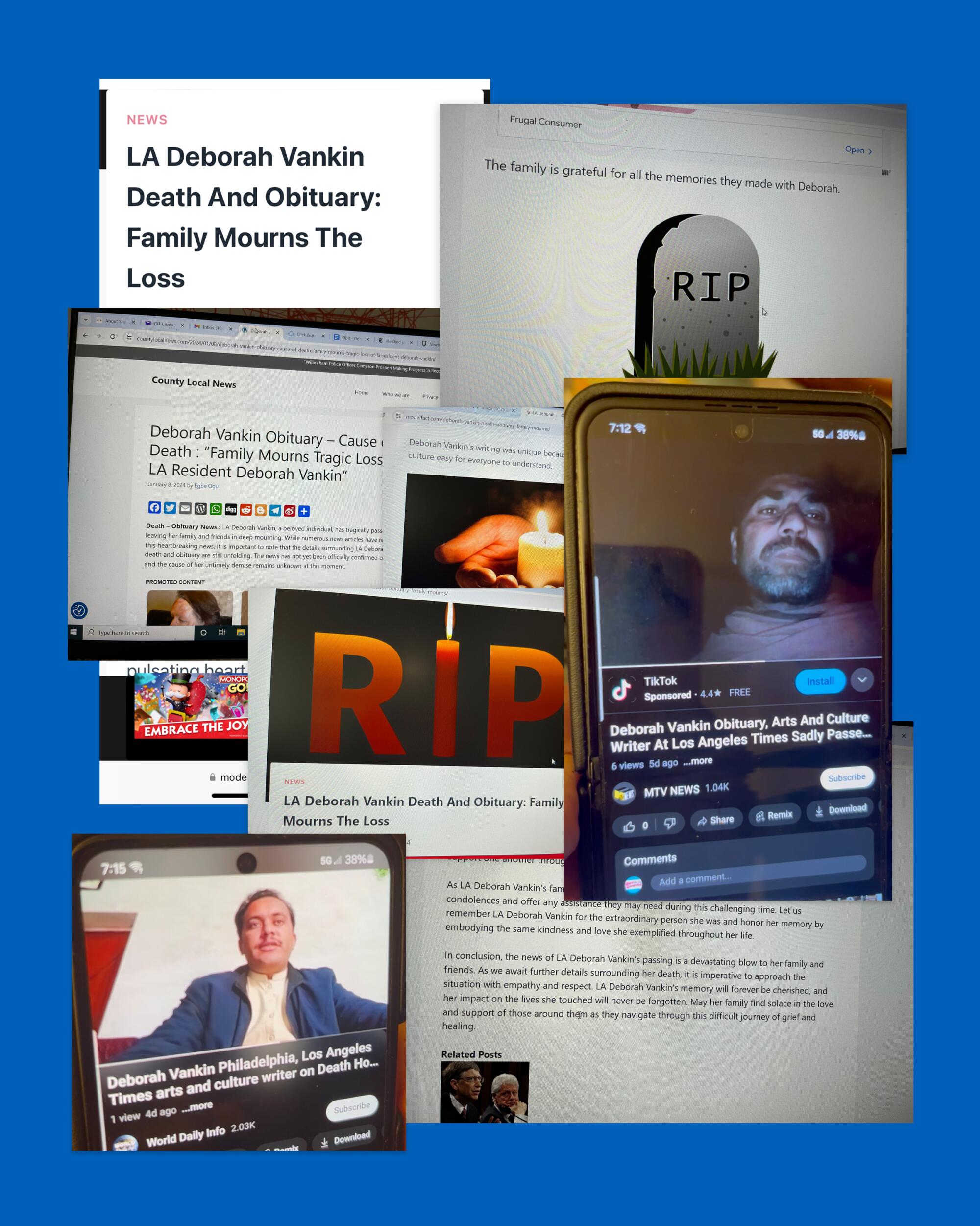
How much money could these scammers really be making off of my name?
“They’re not gonna make a whole lot — per impression, it’s pennies — but with enough clicks, which is why they’re chasing viral trends, it can add up,” says Joshua A. Braun, an associate professor at the University of Massachusetts Amherst who has written about profit-driven online hoaxes. “It’s a few hundred bucks per hoax or scam when it hits. But they can run it at scale using a bot to generate these stories quickly. So a few hundred dollars is not a bad payday for the little time they put into it.”
Though NewsGuard wasn’t able to identify where, exactly, my obituaries came from, the scheme itself offers a hint at their origin.
“Most of these scams originate in the developing world,” said Walter Scheirer, author of the 2023 book “A History of Fake Things on the Internet.” “If you’re one of these scammers, you don’t have to make a huge amount in U.S. dollars. You can still live well in various places.”
My obits appear to have come from multiple entities. After the initial obituary went live, other scammers probably cribbed bits of it, mixing in additional information taken from social media, my Times bio and elsewhere to create new versions of the same story. The overly florid prose focused on my reputation as a professor at Emerson College (“esteemed”), or my journalism (“wielding her pen to unveil the city’s pulsating heart”) or my personality (“her kindness, her warmth”). A blurry, hodge-podge of bogus tributes.
If 2023 was the year AI broke into the mainstream, 2024 will almost certainly bring a whole new slate of developments. We asked several experts what we can expect.
Even more disturbing: This trend has proliferated over the last year. When NewsGuard first started tracking “unreliable AI-generated news sites” with no human oversight in April 2023, it found 49 such sites. As of Jan. 31, it had identified 687 — an increase of about 1,300% in nine months. “We anticipate that by the November 2024 election, there will be around 1,000,” Sadeghi said.
While some scammers have more nefarious motives, such as publishing misinformation to sway public opinion, she said, the most common motive is “programmatic advertising revenue.” In other words, AI bots are generating manipulative death hoaxes for money.
“As these AI tools become more advanced and developed, they’re continuing to be weaponized by more and more people,” Sadeghi said. “It fosters skepticism and doubt and undermines faith and trust in the news at a time when that’s already decreasing.”
“The very qualities that set us apart from these bots — our emotions, our independent thought, our mortality — are also what make us susceptible to them.”
As a journalist, I found this especially disturbing. We want our published stories to get attention, which always comes with its own ups and downs. But I never imagined one of those downsides would be the faking of my death to manipulate my loved ones and others. It was enough to give me pause before writing this piece, which could very well increase my chances of being targeted in another scheme — why poke the bear?
But silencing myself out of fear wasn’t an option. How could I square my public-facing job with the vast threat of unscrupulous online profit-seekers? The death hoax had forced me to look at my life with a rare, bird’s-eye perspective and underlined how important being a journalist was to me. But it’s also just one more reason to worry every time a story with my byline is published online.
What happened to me wasn’t nearly as disturbing as what happened last month to Matthew Sachman, a student who died in a New York subway accident. So-called “obituary pirates” exploited the tragedy by spreading AI-generated misinformation about the accident as clickbait.
In a world subsumed by the internet’s popularity-driven principles, we’re all just one article, incident or social media post away from our names trending online. And the recent surge of AI tools in society means we’re all at a much higher risk of being unknowingly manipulated by the technology, even posthumously. The very qualities that set us apart from these bots — our emotions, our independent thought, our mortality — are also what make us susceptible to them.
At the same time, being cognizant and curious about the dangers of AI, even vulnerable to it, is, in a way, an assertion of our humanity. Perhaps there’s a comfort in that?
Re-reading my obit, for the umpteenth time, I felt melancholic — as much for the world at large as for myself. And I was still plagued by the big questions: not when will I die, but: Who will care? What will I be remembered for? Was I loved?
In this moment of searching, I called my dad, to ask how he’d felt reading the obit.
“It was absolutely chilling,” he said. “Even though I knew it was fake. I was mostly concerned about the emotional impact it would have on you, my daughter.”
If you’re a victim of identity thieves or a data hack, you need to act quickly. Here’s what to do to protect yourself.
Not that I’d ever questioned it, but in that vulnerable moment, I felt especially cared for by him.
The love and concern I felt from the people closest to me, the reminder of their support, was an unexpected gift that came from this surreal journey.
Maybe I wasn’t as OK with death as I’d thought. And I was newly disturbed by the horrors posed by our digital world. But I was also proud of my wonderfully human, imperfect life and the people who made it complete.
I wouldn’t go back and change a thing.
What to do if scammers fake your obituary
More to Read
Sign up for This Evening's Big Stories
Catch up on the day with the 7 biggest L.A. Times stories in your inbox every weekday evening.
You may occasionally receive promotional content from the Los Angeles Times.

